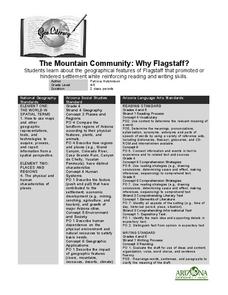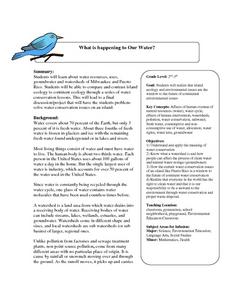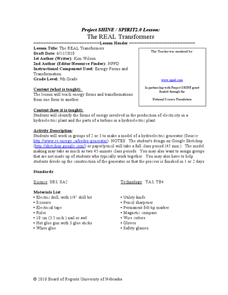Curated OER
The Mountain Community: Why Flagstaff?
Students identify geographical features that hindered or promoted settlement in the city of Flagstaff, Arizona. In this settlement lesson plan, students write a summary of what they learned and identify geographical features on a map.
Curated OER
Animals and Environments
Students listen to stories and identify animals and their young. In this animals lesson, students view videos about farm animals and create illustrations to show how animal babies change over time. Students discuss how they care for...
Curated OER
Who's Who?
Students explore biology by identifying animals and their environments. In this animal characteristic instructional activity, students read assigned text about farm animals, how they are raised, and what they are used for in our society....
Curated OER
Life Beyond the Fifty Yard Line -- An ecological look at our backyard
Students, in groups, stake out and rope off their study area, do population counts and density studies. They construct a map of the whole area, collect plants and insects, and mount and identify the organisms using keys.
Curated OER
Home Sweet Home
Students examine the animals that live in trees. They identify their sounds, footprints and droppings. They draw pictures of the animals as well.
Curated OER
Simplifying sentences
Students read through several articles as a class and identify key words in sentences. Students work as a class to reduce the length of the article by shortening the sentences but ensuring that they still make sense.
Curated OER
Sense-sational
Students investigate the five senses. They participate in the lesson for one week with each day devoted to one sense being sight, taste, sound, smell, and touch. They also cover the concept of being part of a global community where one...
Curated OER
What is Happening to Our Water?
Young scholars compare and contrast Wisconsin's water resources to that of Puerto Rico. They research books about islands, particularly the Puerto Rican islands. Student view illustrations of island ecology. They discuss the...
Curated OER
Watchable Wildlife Checklist
In this wildlife worksheet, students will read over a list of 28 native animal species, their needs, and interesting characteristics. This list can be used as a checklist when out on a hike or in the school yard to identify common wildlife.
Curated OER
Learning from the Video Clips
Students view a wilderness video and write to explain the purpose of the video. In this wilderness video lesson, recognize how physical and living parts of the environment interact. Students understand how an ecosystem works.
Curated OER
What's a Swamp Good For?
Students identify the function and value of wetlands. In this instructional activity on appreciating wetlands, students explain how different household items can represent different aspects of the wetlands.
Curated OER
Vocabulary: Kansas Prairies
Students explore the ecosystem by reviewing scientific vocabulary terms. In this environmental awareness activity, students identify the differences between abiotic and biotic factors and their relationship to the Earth. Students define...
Curated OER
The REAL Transformers
Ninth graders create a model of a hydroelectric generator. In this physics lesson, 9th graders discuss how energy can be transformed from one form to another. They make a flow chart for different energy generating plants.
Curated OER
Sounds of the Wetlands
Students identify the sounds of different bird calls. In this biology lesson, students create a sound map. They explain how this method is important in tracking wildlife.
Curated OER
Designing a Germination Experiment
Students explore botany by participating in a seed experiment. In this plant nutrition lesson, students define several science experiment vocabulary terms like observation, treatment, and replicate. Students utilize soaked seeds in a...
Curated OER
Plant Science: merit badge
In this plant science worksheet, students answer short answer questions about plant science. Students complete 7 questions to get their merit badge.
Curated OER
The Water Cycle: Transpiration
Students identify and describe the stages in the water cycle. Using plants, they determine if they play a role in the cycle and measure the water the plants give off. They complete an experiment to determine if deciduous or coniferous...
Curated OER
Organizing Organs
Fifth graders research plant and animals cells and create a Venn Diagram to show the similarities and differences.
Curated OER
Do you see what I see?
Pupils examine the importance of making and recording observations and accurately describing an object. In this biology lesson students work in groups and report to the class what they learned.
Curated OER
Farm Products Help Me Grow
Students view a display of empty food containers (or illustrations). They select a food and decide as a class if it has an animal or plant origin. Students view a display of common farm animals that are commonly eaten (cow, pig, chicken,...
Curated OER
Exploring Ecosystems
Fourth graders investigate ecosystems. In this ecosystem instructional activity, 4th graders explore producers, consumers, and decomposers and study the interdependence of each.
Curated OER
Food Chains
Students investigate how food chains work. In this food chains lesson, students construct a food web for a pear tree habitat. The interactive whiteboard is an optional tool in this lesson.
Curated OER
Hands-on Cells
Middle schoolers review the components of a cell and the differences between plant and animal cells by creating a three-dimensional model of each type of cell. In small groups, they use modeling clay and household object to construct...

























